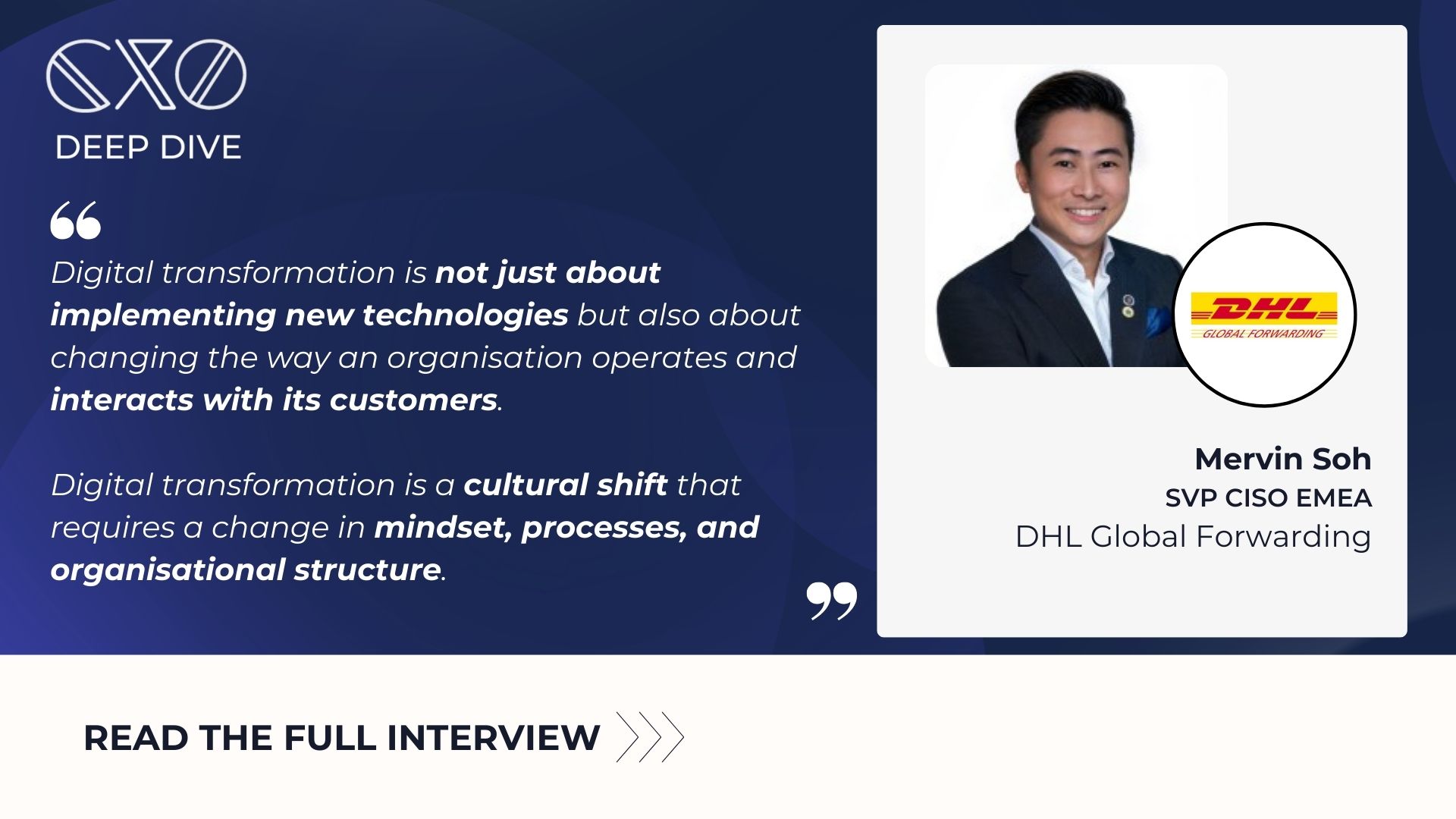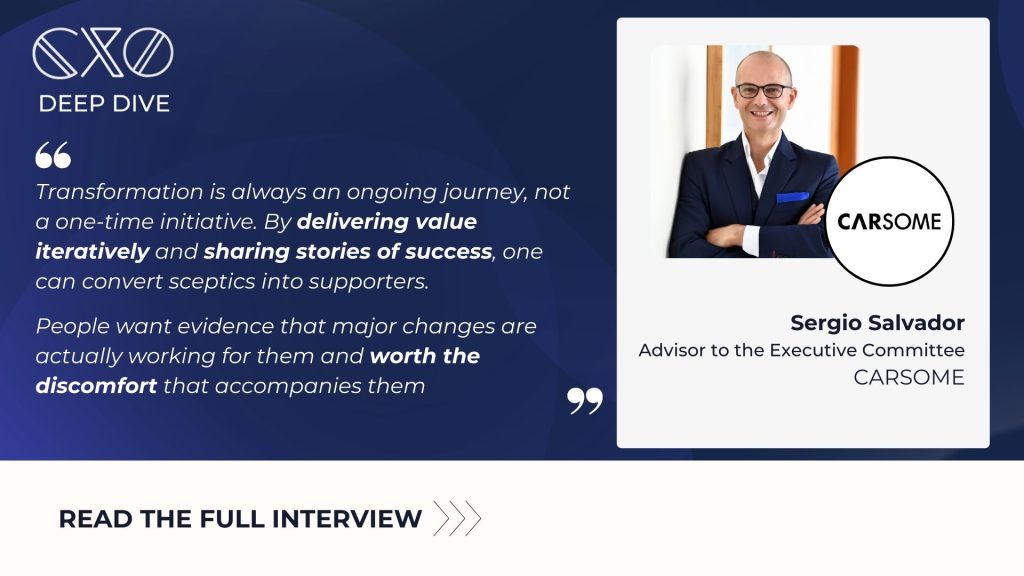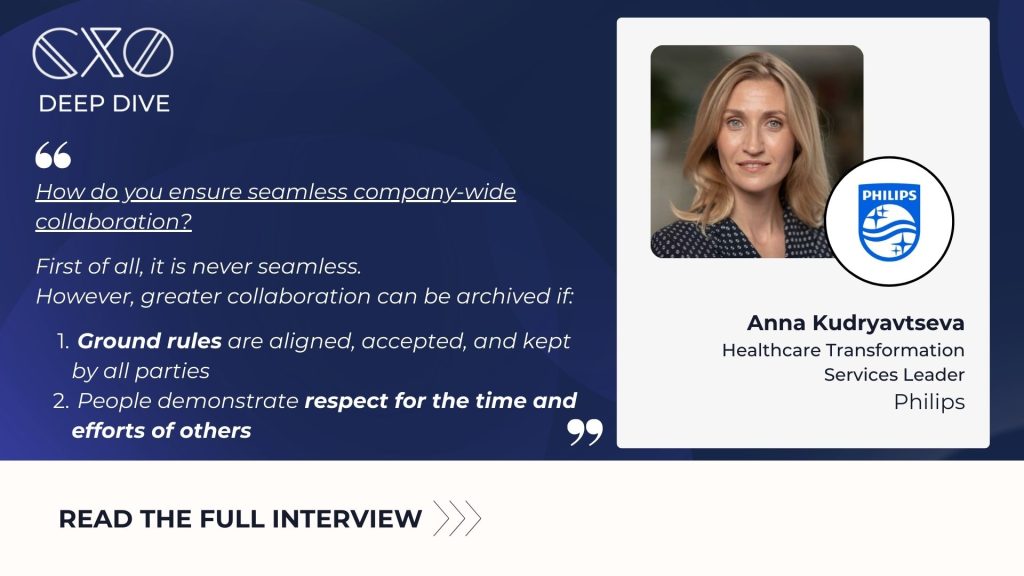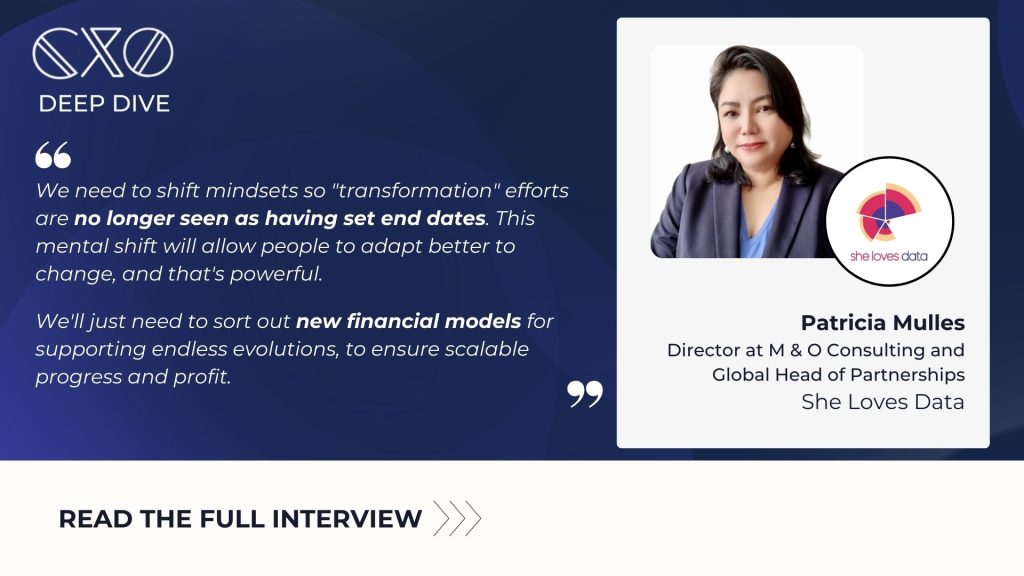Mervin Soh, SVP CISO EMEA, DHL Global Forwarding shares his insights and experiences on Transformation Strategy, Future Trends & Transformation Leadership as part of the CXO Deep Dive series.
How would you explain your job to a 5-year-old?
I will probably leverage child-friendly cybersecurity educational resources. Constantly reminding them about the trending cyber security threats, I will also focus on empowerment than fearing them. Doing so it will then create a trusting, respectful environment for the kids.
“There is no digital transformation, just transformation.” Do you agree or not? Why?
I agree with this statement because digital transformation is not just about implementing new technologies but also about changing the way an organisation operates and interacts with its customers. Digital transformation is a cultural shift that requires a change in mindset, processes, and organisational structure. It’s about leveraging technology to create new business models, improve customer experience, and drive innovation.
However, it’s important to note that digital transformation is not a one-time event but rather a continuous process. Therefore, it’s important to have a long-term strategy that aligns with the organisation’s goals and objectives. Digital transformation is not a separate entity from transformation but rather an integral part of it. It’s a continuous process that requires a change in mindset, processes, and organisational structure. A long-term strategy that aligns with the organisation’s goals and objectives is crucial for the success of digital transformation projects.
What are the top challenges in your business transformation process?
Employee pushback creates the largest barriers to digital transformation.
“It’s crucial to deliver and communicate benefits fast, to build momentum and confidence in transformation projects where there might be scepticism.” Do you agree? Or you have other thoughts on the timeline of a transformation project?
I agree that delivering and communicating benefits fast is important to build momentum and confidence in transformation projects, especially when there is scepticism. However, the timeline of a transformation project depends on various factors such as the scope of the project, the complexity of the changes, the size of the organisation, and the resources available.
In conclusion, while delivering and communicating benefits fast is important, it’s equally important to have a realistic timeline that aligns with the organisation’s goals and objectives. A project timeline can help project managers visualise the entire project plan and ensure that the project stays on track.
Do you see transformation as a distinct skillset, best delivered by “Transformation Experts”, or is it better to be led by the core business?
it’s important to have a clear understanding of the organisation’s goals and objectives before deciding who should lead the transformation.
In general, transformation requires a combination of skills, including technical expertise, business acumen, and change management skills. Transformation experts can bring valuable experience and knowledge to the table, but they may not have a deep understanding of the organisation’s culture, processes, and customers. On the other hand, the core business has a better understanding of the organisation’s culture, processes, and customers, but they may lack the technical expertise required for digital transformation.
Therefore, it’s important to have a collaborative approach to transformation that involves both transformation experts and the core business. Transformation experts can provide guidance and support, while the core business can provide valuable insights into the organisation’s culture, processes, and customers. This approach can help ensure that the transformation is aligned with the organisation’s goals and objectives and that the transformation is successful.
How do you pick the right partners to accelerate digital transformation?
Digital transformation requires a combination of skills, including technical expertise, business acumen, and change management skills. Therefore, it’s important to evaluate the partner’s expertise in these areas before selecting them. It’s important to check the partner’s track record and references to ensure that they have a proven track record of delivering successful digital transformation projects. There is no best partners on earth, but you can always do some homework before qualifying any of them to lead the engagement for you.
How do you ensure seamless company-wide collaboration?
it’s important to have a clear understanding of your organisation’s goals and objectives. This will help you identify the right collaboration tools that align with your organisation’s vision. Centralising communication can help make collaboration easy and keep everyone in your company on the same page.
What aspect(s) of business should organisations prioritise during digital transformation? Why?
Operational efficiency: This tier focuses on using digital technologies to improve operational efficiency and reduce costs. The objective is to optimise existing processes and systems to make them more efficient. Great customer experience focuses on using digital technologies to improve the customer experience. The objective is to create a seamless and personalised experience for customers across all touchpoints.
What is the best way to incorporate agile ways of working to accelerate transformation?
Creating cross-functional teams, such methodology comprising members of business and IT, can help ensure that the transformation is aligned with the organisation’s goals and objectives. Ensure your teammates embrace experimentation. Agile ways of working are based on experimentation and learning. Therefore, it’s important to embrace experimentation and learn from failures.
How do you achieve successful change management and shifts in culture, mindset and behaviours to adopt new digital tools?
Ensure you develop a digital mindset culture in your organisation. Employees must be motivated to use their skills to create new opportunities. Finding the right balance between continuity and change can help leaders better manage the cultural changes that occur during a digital transformation. To sustain a new culture, redesign structures, processes, and technology to support behavioural expectations. Hardwire the desired culture change into all elements of the organisation and transformation.
What do you ultimately do with people that do not want to change?
My personal mantra is “haste is a waste”. It’s important to remember that change is a process, and it takes time. People may need time to adjust to new ideas and ways of working. Therefore, it’s important to be patient and persistent. It’s also important to provide support and resources to help people make the change. This can include training, coaching, and mentoring.
What do you think is the biggest challenge organisations face in the adoption of AI?
The biggest challenge organisations face in the adoption of AI is the lack of the right enablers, both technological and human. Other challenges include a company culture that does not recognise the need for AI, difficulties establishing commercial use cases, a lack of AI expertise, and potential job displacement.
Do you expect certain uses of technology to decline in the near future?
Definitely, with the rise of cloud computing, the use of physical storage devices such as CDs and DVDs has declined significantly. However, it’s important to note that the pace of technological change is unpredictable, and it’s difficult to predict which technologies will become obsolete in the near future.
How do you keep pace with rapid obsolescence in technology? How do you figure out stuff that will be relevant from a future perspective and have longevity from an investment perspective?
Adopting a sunset policy, such policy outlines when and how you will retire outdated technology. This will help you stay organised and avoid unnecessary expenses. Conducting regular risk assessments to identify potential risks and vulnerabilities in your technology infrastructure. This will help you identify areas that need improvement and take proactive measures to mitigate risks. Collaborate with experts in the field to gain insights into emerging technologies and best practices. This will help you stay ahead of the curve and make informed decisions.
How do you decide a change would be beneficial rather than disruptive?
Consider the long-term benefits of the change. Will it help your organisation stay competitive in the future? Will it improve efficiency and productivity in the long run? Involve stakeholders in the decision-making process. This will help you gain buy-in from employees and other stakeholders and ensure that everyone is on board with the change.
What technologies will surely impact the business world & our daily life in 2024 / 2025? Generative AI, Metaverse, Web 3.0, IoT, 5G / 6G or others?
it is reasonable to assume that these technologies will continue to have a significant impact on the business world and our daily lives in the coming years.
Generative AI, Metaverse, Web 3.0, IoT, and 5G/6G are all emerging technologies that have the potential to transform the way we live and work. IoT refers to the interconnectivity of devices and sensors, which can be used to collect and analyse data. 5G/6G is the next generation of wireless technology, which promises faster speeds and lower latency.
While these technologies are still in their early stages, they have the potential to revolutionise the way we live and work. However, it’s important to note that the pace of technological change is unpredictable, and it’s difficult to predict which technologies will become mainstream in the near future.
How is your industry preparing for an AI-Centric world?
AI-powered robots are being used to automate repetitive tasks such as sorting, packing, and labelling. We DHL have since partnered with Dorabot, an AI-powered robotic solution provider, to integrate “DHLBots” into their hub and gateway. AI is being used to analyse large volumes of data to identify patterns and insights that can help optimise logistics operations. For example, AI can be used to predict demand, optimise routes, and reduce delivery times. The logistics industry is adopting a human-centric approach to AI adoption. This approach ensures that the expertise of forwarders and customs brokers is complemented by the AI solutions they are using. This enables critical thinking, creativity, and new levels of customer service to take priority.
How has your approach to transformation changed due to new tools and solutions?
Translate strategic goals into a bold yet realistic transformation ambition. This will help you stay focused on your goals and ensure that your transformation efforts are aligned with your overall business strategy. Build the discipline needed to establish a new trajectory that helps keep pace with disruption. This will help you stay agile and adaptable to remain competitive in today’s fast-paced world. Take time to be explicit about exactly how you intend to create value. This will help you identify areas that need improvement and take proactive measures to mitigate risks.
Do you see automation as a path to drive operational efficiencies and ultimately save cost?
Yes, automation can be a path to drive operational efficiencies and ultimately save cost. According to a report by Harvard Business Review, automation is one of the fastest ways to improve efficiency and productivity across every department: sales, service, marketing, commerce, IT, human resources, finance, and more. Automation reduces the repetitive and monotonous tasks humans have to do by relegating those tasks to software, which usually means a better experience for customers, reduced error rates, improved compliance, and lower stress for teams. By automating routine but essential tasks, you can increase workflow efficiencies, free up your staff for higher-value work, and drive down costs while boosting revenue.
Can you give an example of how you’ve engaged with front-line staff at the outset of a transformation project, your approaches, and the outcome?
Actively Involve front-line staff in the transformation process from the outset. This will help you gain buy-in from employees and other stakeholders and ensure that everyone is on board with the change. Provide clear communication about transformation objectives and progress. This will help keep front-line staff informed and engaged throughout the process. Offer training and development opportunities to help front-line staff develop the skills needed to work with new tools and solutions. This will help ensure that they are prepared for the changes ahead.
What are the challenges your organisation faces in people up-skilling, which becomes one of the basic needs to drive complex transformation?
Upskilling employees is a critical aspect of driving complex transformation in organisations. However, it is not without its challenges. To overcome these challenges, organisations need to craft an effective employee upskilling plan. Identifying the barriers that exist in the organisation is the first step. Upskilling employees is key to developing top tech skills, bolstering technologists’ skill confidence, and filling organisational skills gaps.
What are the typical aspects that undermine a transformation position?
The success of a transformation initiative depends on several factors, including the roles and responsibilities of the individuals involved. A digital transformation consultant, the most important role for the CEO in a transformation initiative is that of a visionary who shows the organisation the way by communicating a compelling story and being a visible and vocal advocate for the transformation. In addition to the CEO, there are several other key roles that need to be defined and fulfilled in order to ensure success. These roles may vary depending on the scope and nature of the transformation initiative, and may include additional roles as needed.
Suppose successful transformation is done diplomatically and in the background. How do you avoid the risk of it not being sufficiently valued by the company?
If a transformation is done diplomatically and in the background, there is a risk that it may not be sufficiently valued by the company. To avoid the risk of transformation not being valued by the company, it is important to develop a comprehensive transformation strategy that is aligned with the organisation’s strategic goals. Business leaders must communicate the value of digital transformation and secure support for the plan from across the business.
What other aspects during transformation need to be addressed beyond digital competence?
Leadership alignment: Ensuring that all leaders are aligned around the transformation vision and are committed to driving change. Employee engagement: Engaging employees throughout the process and ensuring that they are motivated and committed to the transformation. Clear transformation goals: Crafting a clear and compelling transformation vision that is aligned with the organisation’s strategic goals. Effective communication: Communicating the value of digital transformation and securing support for the plan from across the business.
Do you have any advice on how to create an environment for employees to share more?
Be a better listener: When your employees speak up, let them clearly and completely deliver their message, and then double back to make sure you heard them correctly. When your staff sees that you are an empathetic listener, they will more than likely speak up more often. Be open by example: Leaders encourage employees to speak up by showing vulnerability. They exhibit the behaviour they desire to create by displaying authenticity in their words and actions. When a leader allows themselves to be fully exposed, it builds trust and collaboration becomes easier.
What technology / solution would you invest in if you were an Angel Investor?
Probably not, because upkeeping a technology can be painful. I would rather get myself involved in Food & Beverage.
What’s the best advice someone has ever given you regarding transformation?
Haste is waste; take your time to strategise. Gather the right buy-in from various stakeholders, and establish good working relationships with your peers before you talk about transforming the organisation.
A big thank you to Mervin Soh for sharing the insights on Transformation Strategy, Future Trends & Transformation Leadership!
Visit our content library for more insights from the CXOs: https://cxoinnovation.com/content-library/
Join our LinkedIn CXO Community.





